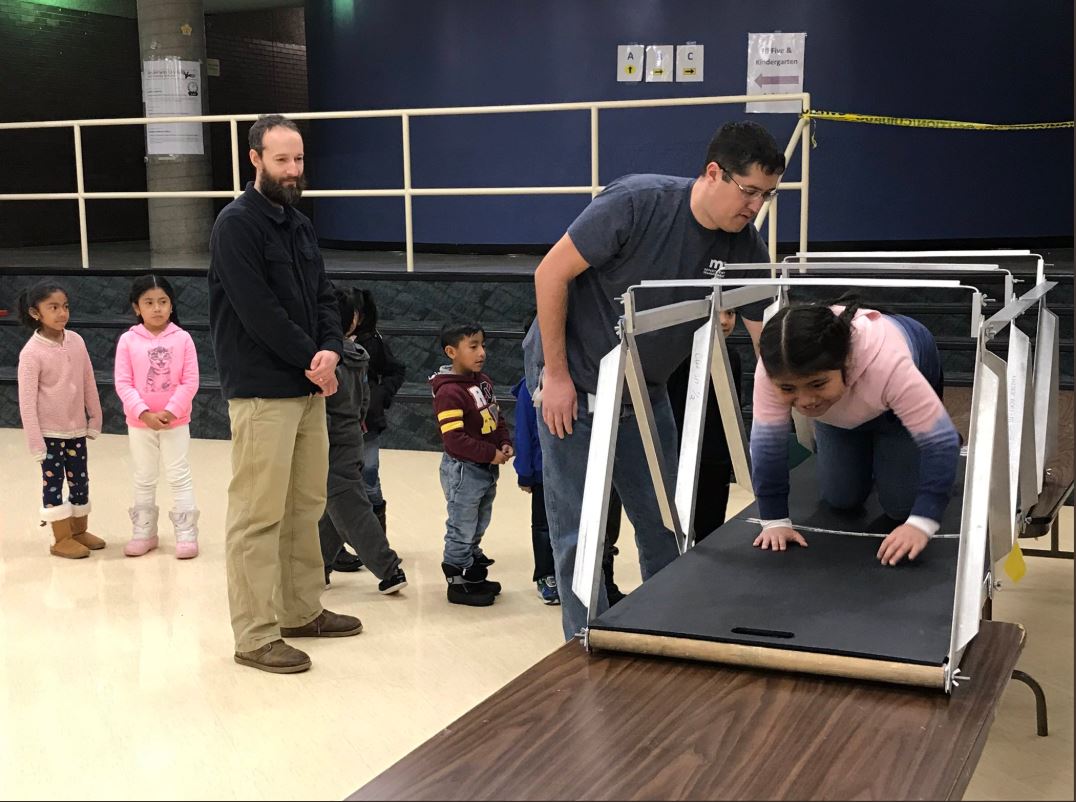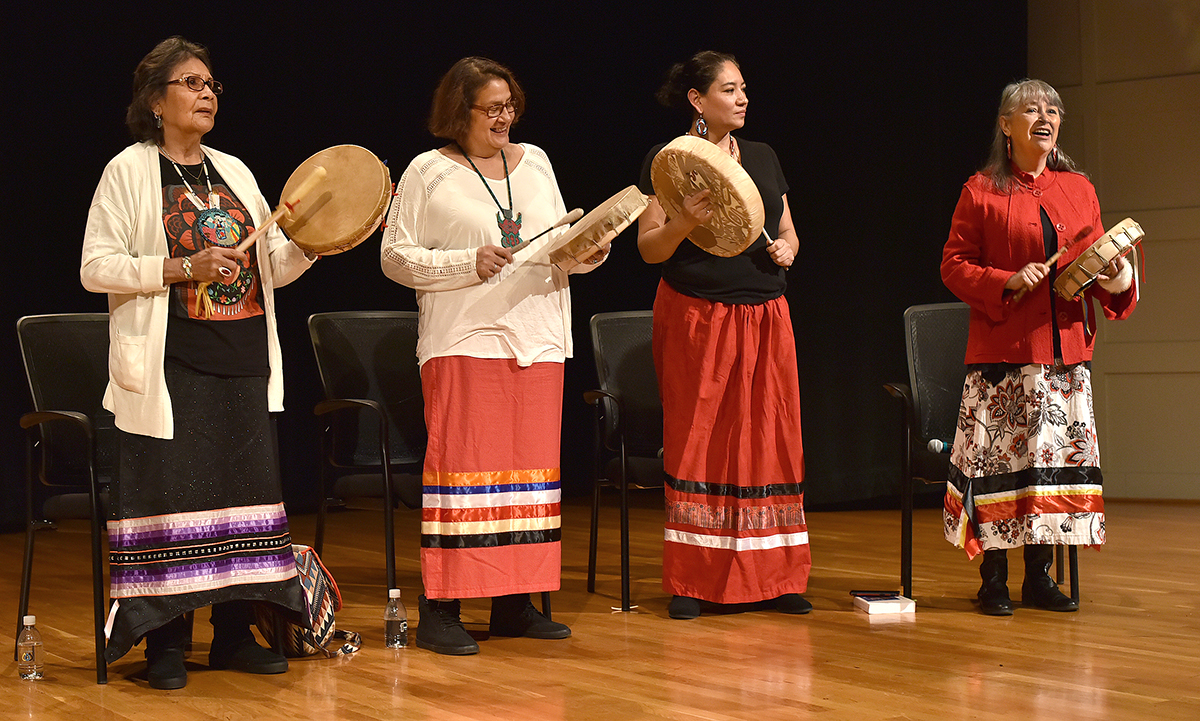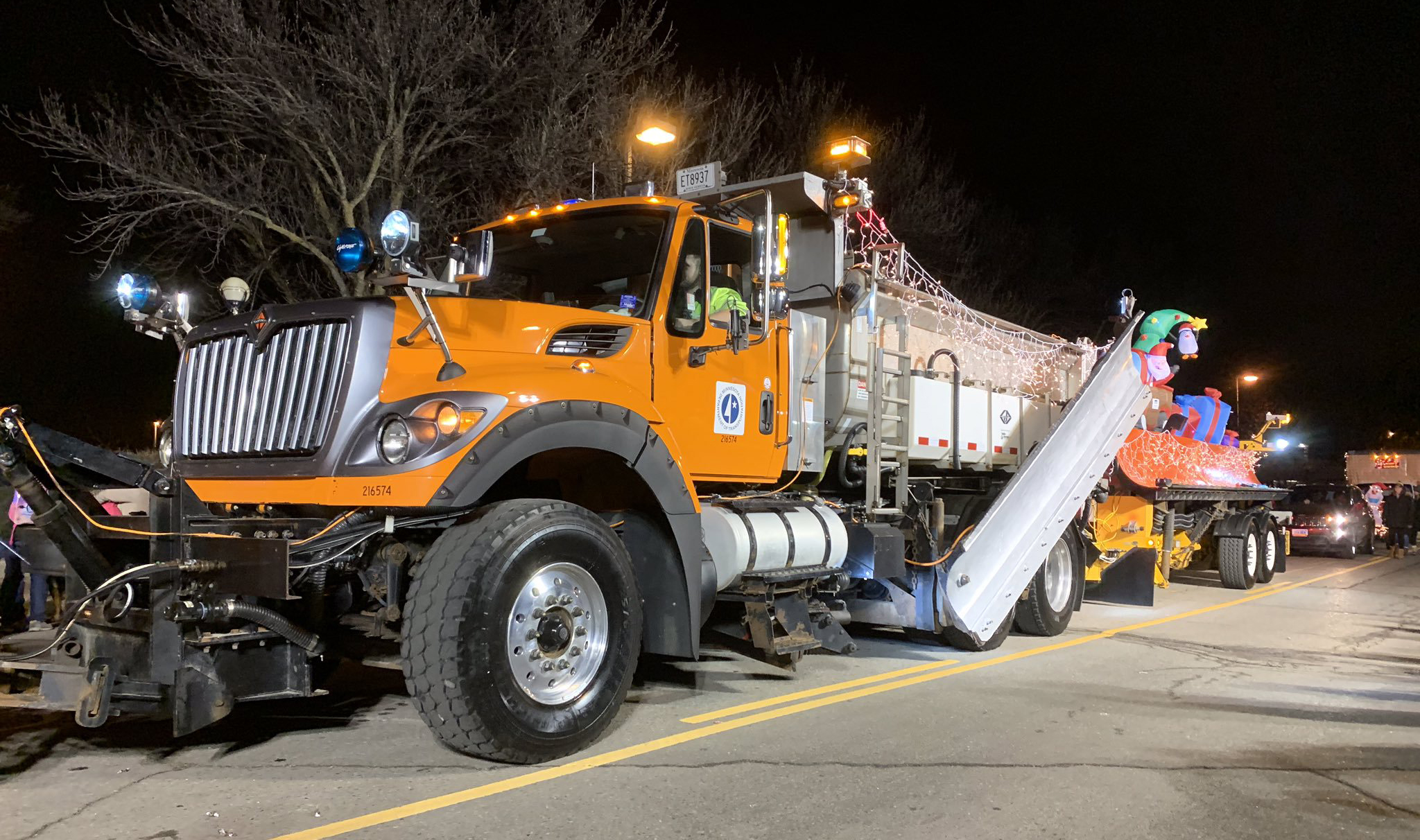 |
|

|
 |
TABLE of CONTENTS
 |
Metro District tests sensor-based system to improve safety on Hwy 12 |
By Nick Carpenter
Several fatal, head-on crashes have occurred on Hwy 12 in the west Twin Cities metro in recent years.
MnDOT has been working closely with the Highway 12 Safety Coalition to help improve safety on the highway. This includes the installation and testing of a first-of-its-kind system on the highway between Delano to Orono that alerts motorists when the road is slippery. The sensor-based system measures the friction of the pavement. If any of the 10 sensors in the area detects that the friction is reduced, it activates two dynamic message boards and multiple flashing yellow beacons to warn motorists of slippery conditions. Watch the video to learn more.
|
 |
|

|
 |
TABLE of CONTENTS
 |
State Fair wing blades battle winter snowfall |
By Anne Meyer

Photos by Anne Meyer |
In a battle between snow and Sharpie signatures, snow seems to be winning, at least partially.
Take a look at what happened to several of the Minnesota State Fair signed wing blades after one week of work. Visitors to MnDOT’s State Fair booth inside the Education Building signed their names and hometowns on five 9-foot snowplow wing blades. By the end of the fair, all five blades were full of signatures.
Two of those wing blades have been deployed in the Twin Cities metro area, with one at the Maryland truck station and the other in Oakdale. A third blade recently plowed snow along Hwy 61 along the north shore from Beaver Bay to Schroeder and will be stationed in Silver Bay for the rest of winter. The two remaining signed wing blades will go to work after the New Year in Districts 7 and 8.
Follow the progress of the signed wing blades on MnDOT’s Twitter and Facebook pages.
|
 |
|

|
 |
TABLE of CONTENTS
 |
MnDOT launches drone Shared Service |
|
By J.P. Gillach

Katie Gilmore and Tony Fernando pilot a drone from MnDOT’s new UAS Shared Services fleet. MnDOT’s drones can capture high-resolution photos and videos, collect data for 2-D/3-D modeling, provide thermal images for inspections and perform other functions. Photo by Jim McCanney |
MnDOT’s new Unmanned Aircraft System Shared Service allows MnDOT offices to efficiently order drone services.
The Office of Aeronautics has decades of experience supporting aviation infrastructure and offering flight services for official business, and recently added drones to its fleet. Its drone program currently includes three pilots and six aircraft.
MnDOT’s drones can take high-resolution videography and photography that can be used for inspections, site mapping (e.g. project management or site planning), public engagement, documentation (e.g. right of way, traffic, lighting) and more. Thermal drone services are available for building inspections (water intrusion, air leakage), solar panel inspections or other applications.
Visit the Shared Services webpage to learn how to request drone services for data collection, documentation, video or other needs. To view the MnDOT drone demo video and learn about uses, visit the Office of Aeronautics’ drone iHUB page.
Districts should contact the Office of Aeronautics soon to begin planning their 2020 construction season’s UAS-SS flight schedules for milestone documentation. While UAS-SS can respond to emerging projects or new ideas, advance scheduling will maximize efficiency.
Drone pilots and services are regulated by the FAA, state and local regulations, and MnDOT’s Policy OP006. Any drone activity by a MnDOT employee or contractor must be approved in advance by MnDOT’s Office of Aeronautics. Contact Katie Gilmore or Tony Fernando at DroneInfo.DOT@state.mn.us for more information.
MnDOT’s Shared Service Program builds operational efficiencies, reduces redundancies and streamlines work functions. All of MnDOT’s Shared Services (Blowing Snow, Public Engagement, Real Estate, and Traffic) also have diverse funding structures that enable districts to pay for the services they need, based upon use of the service. Funding sources include SRC, non-SRC consultant, BARC, Maintenance and HSIP.
Contact Marilyn Jordahl Larson, Shared Services program director, for further information about MnDOT’s Shared Services Program.
|
 |
|

|
 |
TABLE of CONTENTS
 |
Northern Lights Express supporters weigh-in at Duluth hearing |
By Mary McFarland Brooks
Is Minnesota on track to seeing a passenger rail line between the Twin Cities and Duluth?
Commissioner Margaret Anderson Kelliher, along with Frank Loetterle, project manager, and Duane Hill, District 1 engineer, provided information to the House Transportation Finance and Policy Committee Dec. 11 at the Kirby Student Center on the University of Minnesota-Duluth campus. The hearing mainly featured testimony on the Northern Lights Express passenger rail project proposed between the Twin Cities and Duluth.
Hill provided details on the Twin Ports Interchange reconstruction project and other transportation projects in the region. Anderson Kelliher said that the NLX project would be “highly utilized.” She also thanked lawmakers for previous funding and added that existing support is too limited for current transportation needs.
Loetterle provided details about the proposed NLX project that would operate between Minneapolis and Duluth on 152 miles of existing BNSF track, including:
- Six stations located in Minneapolis, Coon Rapids, Cambridge, Hinckley, Superior and Duluth
- 90 mph maximum speed, 60 mph average speed
- Two-and-a-half-hour travel times between the Twin Cities and the Twin Ports
- Four round-trip trains per day between Duluth and Minneapolis
- $30-$38 ticket price
- Approximately 1 million annual riders by 2040
The committee also heard testimony on a bill to fund $4 million for engineering completion of the NLX project. If approved, the bill would be a key action for releasing potential state and federal funding on the proposed $550 million project, which likely would be split 40-60 by state and federal governments, respectively.
Once full funding is in place, the rail service could be operational in less than three years.
More information
|
 |
|

|
 |
TABLE of CONTENTS
 |
Leadership Development Program enrollment open until Jan. 17 |
By Shawn Meade, Leadership Development Program
Are you interested in higher confidence and motivation, better communication with team members and customers, increased responsibility and ownership, better time management skills, and more overall knowledge about MnDOT?
Employees’ motivation and willingness to improve their competencies allows MnDOT to remain adaptable and productive, and ultimately provide quality service to its customers. This can be achieved through the Leadership Development Program, with little to no expense other than one’s time and attention.
“Employees are realizing the benefits of participating in the program and using its resources to assist them with their development,” said Carol Hennekens, Leadership Development Program manager. “The 2019-20 program year, which started in September, is offering many new learning opportunities and additional resources that will support new, as well as past participants, who want to enroll again.”
Open to all employees, the program is individually customized and flexible to meet participants’ development goals. It can be structured, informal, rigorous, ongoing and flexible all at the same time. This unique program requires participants to create their own development goals and set their own development schedule to fit their busy work schedule.
The LDP is offered to all employees. The uniqueness of the program allows participants to create their own goals and work on them at their own pace.
Group 14 open enrollment runs through Jan. 17, 2020. To learn more about the Leadership Development Program, and how to enroll in Group 14, visit the LDP website.
|
 |
|

|
 |
TABLE of CONTENTS
 |
Aesthetic Market Research project seeks statewide perspective |
By Joseph Palmersheim
From dense urban corridors like Interstate 94 to state highways that are the main streets of rural Minnesota, the maintenance and quality of highway roadsides impacts the attractiveness of the state. But what kind of value does that add to the state’s economy and quality of life?
To get a better understanding, MnDOT engaged a consultant to conduct a market research project this year to gather input from the public and key stakeholders. The project sought to elevate non-transportation voices through an online public opinion survey of 800 Minnesotans representative of the state; stakeholder focus groups with leaders in tourism, business, economic development and government; and group interviews in Greater Minnesota with regional development commissions, tourism professionals and MnDOT district leaders.
“Leaders in economic development and tourism underscore how highway roadsides contribute to first impressions of the state of Minnesota and by extension, our economic vitality,” said Jessica Oh, highway sponsorship director with the Office of Land Management. “Minnesotans expressed a desire for transportation infrastructure that expresses a ‘sense of place,’ highlighting how MnDOT’s right of way can support livability and quality of life for communities.”
Results from the recently completed report include:
- MnDOT has an opportunity to use the highway sponsorship program to involve large businesses and arts/culture organizations in enhancement and maintenance of the right of way, along with opportunities to engage external partners to enhance gateways in all environments (urban, rural, suburban, commercial districts, state entrances)
- Smaller communities need long timelines to plan/fund aesthetic enhancements (10-years plus) to align local economic development goals with MnDOT construction projects. Communities across Greater Minnesota requested case studies on rural communities that have invested in enhanced aesthetics within construction projects to support rural community development goals. As a result of this project, the highway sponsorship program is evaluating additional strategies to support aesthetics in collaboration with other offices.
- Aesthetic elements in transportation infrastructure should reflect the unique character of communities – a “sense of place.” MnDOT has a role to play in working with local champions to activate outside resources for highway roadside enhancement projects.
- Green infrastructure, art and placemaking can support environments that encourage biking and walking. These enhancements connect aesthetic elements with public health and safety.
- The condition of highway roadsides impacts perceptions of a community’s economic strength, resident’s feelings of pride-in-community and perception of safety. Half of respondents indicated that highway roadsides impact quality of life and visually pleasing highways reduce stress related to commuting.
Next steps include creating profiles of communities that have made aesthetic investments (for instance, in St. Peter, Alexandria, Battle Lake) to learn of how they aligned local investment with a transportation project. The highway sponsorship program is also looking to develop additional guidance for internal and external audiences, including MnDOT project managers and communities working on aesthetic initiatives to harness the power of outside resources and public-private partnerships.
|
 |
|

|
 |
TABLE of CONTENTS
 |
'MnDOT was his family' - coworkers remember George Wackerfuss |
By Joseph Palmersheim

A memorial photo of George Wackerfuss on a tree decorated for the holidays in Central Office. Photo by Joseph Palmersheim |
George Wackerfuss, accounting officer senior at Central Office, died Dec. 7.
Wackerfuss started with MnDOT in September 1972. During his 47-year career, he served in a variety of accounting positions, starting as a clerk.
“You couldn’t have asked for a better coworker,” said Mary Koester, accounting director. “He was witty, hardworking, and willing to help others. He never said a bad thing about anyone.”
Sheila Cornelius worked with Wackerfuss for more than 30 years.
“We all loved George so much,” she said. “For George, MnDOT was his family.”
Wackerfuss was known around Central Office for his extensive collection of sports jerseys, which he wore to work. Cornelius said he was particular about what kind of jerseys he wore, adding that many of them were authentic and some were signed by players.
Service information was not available before this article’s publication deadline.
|
 |
|

|
 |
TABLE of CONTENTS
 |
Bridge in a Bag gives future engineers a chance to build |
 
Paul Miller (pictured above right, in blue shirt) from the Office of Freight and Commercial Vehicle Operations and Alex Bruch from the Office of Maintenance visited first-grade students from Andersen United Community School in Minneapolis Dec. 6.
Students learned about basic engineering concepts, including the various types of bridges MnDOT builds. They also learned how different shapes and materials are used for strength, and their ability to hold tension and compression. To finish the lesson, students built their very own 6-foot-by-2-foot bridge from MnDOT’s Bridge-in-a-Bag kits. The students sent a thank-you note after the activity (at right).
The visit was part of MnDOT's Science, Technology, Engineering and Math program, which promotes STEM activities to kindergarten through post-secondary audiences. Photos by Kelly O'Brien |
|
 |
|

|
 |
TABLE of CONTENTS
 |
Shipping season draws to a close |

Shipping season on the Mississippi River in Minnesota ended Nov. 28 when the Motor Vessel Kelly Rae Erickson passed through Lock and Dam 2 at Hastings. The river shipping season usually opens in mid-March. However, in 2019 the season opened later than usual. Periods of high water downstream also slowed or halted up-bound boats at least three times in late spring and early summer, which also led to St. Louis harbor completely closing for a period. Preliminary U.S. Army Corps of Engineers statistics show a 30 percent decrease in tonnage from 2018. Photo by U.S. Army Corps of Engineers |
|
 |
|

|
 |
TABLE of CONTENTS
 |
Indigenous, Latino-American employee resource groups co-host 'Honoring our Ancestors' |

The Indigenous and Latino-American employee resource groups co-hosted “Honoring our Ancestors” in celebration of Native American Heritage Month Nov. 20. They invited the Ogitchida Ikwe Council, formed by a group of grandmothers from the Elder’s Lodge in St. Paul. Council members work to address sexual violence in the Native American Community, provide advocacy training and make traditional drums. The drum group sang several songs, shared inspiring stories and exchanged with the audience on Native culture. Photo by Rich Kemp |
|
 |
|

|
 |
TABLE of CONTENTS
 |
Snowplows light up the night on parade in District 4 |

District 4 employees got into the holiday spirit at the Detroit Lakes Grand Parade of Lights Dec. 2 and Fargo-Moorhead Holiday Lights Parade Nov. 26 (above). At each parade, a snowplow donned lights and decorations - instantly becoming fan favorites. Photo by Luke Fellbaum |
|
 |
|

|
 |
TABLE of CONTENTS
 |
On the Job: Chang Pao Yang develops automated workflows |
By Joseph Palmersheim
Chang Pao Yang serves as a workflow development specialist in his role as a management analyst in Central Office. He started as a student worker, and has worked for MnDOT for more than 10 years. His favorite part of the job is when he gets to roll out a completed project for the offices to use and see the impact that it has. The image below is linked to a larger version.

Do you or a co-worker have an interesting job to share with readers? Send us your ideas, and we’ll contact you for more information.
Recent employee profiles:
|
 |
|
| |
|



